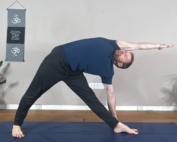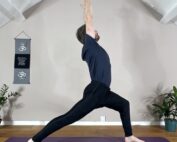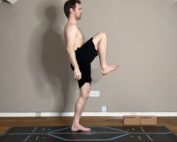
Enhance Your Yoga Routine with Trikonasana: Steps, Benefits, and Variations
I’m Dav Jones, a senior yoga teacher and teacher trainer. In this blog, we’ll explore the beauty and depth of Trikonasana (Triangle Pose). We’ll delve into its significance in yoga asana, uncover its numerous benefits, highlight the key muscles engaged, and walk through essential preparatory poses. Together, we’ll go step-by-step through the posture, discuss useful modifications, and consider any potential precautions. Join me as we navigate how to master Trikonasana safely and effectively, elevating your yoga practice. Let’s get started!
What is Trikonasana?
Trikonasana or Triangle Pose is a fundamental yoga posture that involves forming a triangular shape with the body. The pose is named for the three distinct angles it creates. Trikonasana deeply engages the legs, stretches the hips and provides a deep stretch to the Quadratus Lumborum muscle of the lower back.
Trikonasana Translation
- Sanskrit: Trikonasana
- Pronunciation: Tri-ko-na-sa-na
- Meaning of Trikonasana: “Tri” means three, and “kona” means angle. Together, they describe the triangle shape formed by the body in this posture, representing balance, strength, and alignment
- .Yoga Level: Beginner to Intermediate
- Pose Type: Standing
Benefits of Trikonasana
Trikonasana, or Triangle Pose, offers a wide array of physical and mental benefits, making it a staple in many yoga asana practices.
Physical Benefits
- Stretches and Strengthens the Body: Trikonasana provides a deep stretch to the hamstrings and adductor group in the front leg,and outer hip muscles in the rear leg. It strengthens the muscles in the thighs, knees, and ankles, while also improving the flexibility of the hips and hamstrings.
- Enhances Balance and Stability: This pose can be challenging to your balance, and requires intentional contraction through the front and rear leg muscles to maintain stability and empowerment in the posture.
- Increases Blood Flow: By stretching the body and opening up the chest, Trikonasana enhances circulation, particularly to the heart and lungs, which can improve cardiovascular health and respiratory function.
Mental and Emotional Benefits
- Reduces Stress and Anxiety: The grounding nature of Trikonasana can help to calm the mind, reduce stress, and alleviate anxiety. The focus required to maintain balance and alignment in the pose draws your attention inward, promoting a meditative state.
- Boosts Mental Clarity: The focus and concentration needed to maintain the posture helps to sharpen mental clarity and improve focus, making it a great pose to practice before tackling mentally demanding tasks.
Preparatory Poses for Trikonasana (Triangle Pose)
Before diving into Trikonasana, it’s essential to warm up and prepare the body with poses that open up the hips, stretch the hamstrings and apply postures that allow an ease to your breathing. Here are some effective preparatory poses:
1. Parsva Supta Padangusthasana

- Purpose: This supine posture is a great preparatory pose to stretch the necessary leg muscles for Trikonasana. Due to the nature of the pose, this supine version also takes out the standing aspect of the Trikonasana posture.
- How to Practice: Lie on your back, and bring one leg into hip flexion. Collect the big-toe with the peace fingers of the same-side arm (use a strap if you don’t have the flexibility) and abduct your leg out to the side. Keep the bottom foot active by pressing the heel into your mat.

- Purpose: Lizard pose is a great prep pose to further open up the necessary muscle and connective tissue of the legs for Triangle pose.
- How to Practice: Start in All-Fours and step your right foot to the outside of the right hand. Lean your hips forward to move deeper into the posture. If you have the hip flexibility lower down onto your forearms.
3. Virabhadrasana II (Warrior II)

- Purpose: Warrior II builds strength in the legs and hips preparing the and establishes the wide stance and alignment required for Trikonasana.
- How to Practice: Step your feet wide apart, direct your front toes directly forward and align the outer rear foot parallel to the short edge at the back of the yoga mat. Bend the front knee directing the centre of the knee towards the second toe in the front foot.
Align the front and rear in a position that feels spacious in the anterior groin region of your hips.
-
Utthita Parsva Padangusthasana (Extended Hand-to-Big-Toe Pose to the Side)

- Purpose: This standing balance posture is another great pose to stretch the necessary hip muscles in preparation for Trikonasana.
- How to Practice: Start in Tadasana (Mountain Pose). Find a fixed gaze and bring your right leg up into hip flexion. Collect the big-toe with the peace fingers of the right hand. Slowly, straighten out the leg and take the leg out the right. Gradually, turn your gaze looking over the left shoulder. Maintain the balance for 5 breaths.
Step-by-Step Guide to Performing Trikonasana (Triangle Pose)

1. Begin in Virabhadrasana II (Warrior 2)
I find that a suitable entry into Trikonasana is from Warrior 2. The reason being for this is you can apply the necessary outer hip stability in the front leg with the knee bent. Some primary hip stabilising muscles worth contracting when the legs are in hip abduction and external rotation is the Gluteus Medius muscle. To do this, with the front leg bent, press down through the mound of your big-toe and outer heel of the foot. Keeping the weight through these points in the front foot, draw the front thigh laterally until you feel an engagement in the muscles in the outer region (‘front pocket’ area) of your front hip.
2. The Distance and Placement of your Feet
Have your feet about 3-4 feet apart, depending on your height and flexibility. Keep the front toes pointing forward towards the top edge of your yoga mat and the rear toes slightly turned in at around a 45 degree angle.
Give yourself permission to explore placement of your feet and rotations of your hips until you can sense ‘space’ in Trikonasana.
3. Keeping the Outer Hip Stability in The Front and Rear Hip
Keeping the tone and awareness of engagement we achieved from point ‘1’ slowly start to straighten out the front knee. I would suggest not to fully ‘lock-out’ the knee joint and keep a slight bend in the knee. Press your front foot firmly down into your mat.
Through the rear leg, rotate your thigh inward (internally) whilst pressing through the mound of the big-toe and outer-edge of the rear foot.
Give yourself permission to explore placement of your feet and rotations of your hips until you can sense ‘space’ in Trikonasana.
4. Position Your Arms
Abduct your arms horizontally, reach forward through the front arm, bringing length to the bottom side-body. Then place the front hand at a comfortable place on the front leg. Reach through the fingers of the top hand and slightly back with the arm, retracting the top arm shoulder blade.
5. Open the Chest
Reaching through the fingers of the top hand and slightly back with the arm opens the chest bringing expansion into the anterior ribcage.
6. Breathe in Trikonasana
Have 4 to 5 breaths in the pose. Spend longer if your intention is to intensify the experience.
7. Release and Switch Sides
Inhale to rise back up to standing, extending both arms out to the sides and repeat from Warrior 2 on the other side.
Modifications and Variations for Trikonasana (Triangle Pose)
-
Beginner Modifications
If you’re just starting with Trikonasana, here are a few adjustments to make the pose more accessible:
- Use a Yoga Block: Place a block on the outside of your front foot to rest your hand on. This helps maintain proper alignment without straining your hamstrings or lower back. The block provides support and allows you to focus on stability and maintenance of a steady breath.
- Shorten Your Stance: If balancing in the full expression of the pose feels challenging, bring your feet closer together. This reduces the intensity of the stretch and helps you find a less challenging stance.
- Wall Support: Practice with your back against a wall. This helps provide support for the body and can be a great teacher in exploring different joint nuances of the posture.
-
Advanced Variations
For those looking to deepen their practice, these advanced variations of Trikonasana will challenge your balance, flexibility, and strength:
- Parivrtta Trikonasana (Revolved Triangle Pose):

This variation involves twisting the torso in the opposite direction, bringing the opposite hand to the outside of the front foot while extending the other arm up towards the ceiling. This variation enhances spinal flexibility and strengthens the core.
2. Bound Triangle Pose:

In this variation, the lower hand reaches under the front leg to clasp the upper hand behind the back. This deepens the stretch in the shoulders and chest and requires significant flexibility in the hips and hamstrings.
3. Extended Triangle Pose with a Deeper Side Stretch:

Instead of reaching your hand directly down, you can extend it over your head, parallel to the floor, creating a longer line from your back heel to your fingertips. This intensifies the stretch along the side body.
Trikonasana in a Yoga Sequence
Trikonasana is a versatile pose that fits seamlessly into various yoga sequences. It can be incorporated into a standing sequence, transitioning smoothly from poses like Warrior II or Extended Side Angle Pose. Trikonasana also works well as a middle or end sequence pose, helping to balance the body after more intense postures. This pose not only enhances flexibility and strength but also prepares the body for deeper stretches and twists.
The Role of Breath in Trikonasana
Breath plays a crucial role in Trikonasana, enhancing both physical alignment and mental focus. Breath typically moves into parts of the lungs that are expressing volume area. A worthwhile practice in Trikonasana is to focus on expanding into the rib cage located at the upper side-body of the posture. This method of breathing in postures is not only beneficial in Trikonasana but also many other yoga asana postures of the yoga practice.
Final Thought
If you’re inspired to deepen your yoga practice and explore the benefits of Trikonasana further, join the Dav Jones Yoga online classes available on Patreon. With sessions tailored to various skill levels, there’s something for everyone, whether you’re a beginner or an advanced practitioner. Additionally, the DJY mentorship program offers personalised guidance to help you refine your poses and truly understand the transformative power of yoga. These online resources are crafted to support your journey, helping you elevate and evolve your practice with Dav Jones Yoga. Embrace the path and transform your yoga experience with us.









